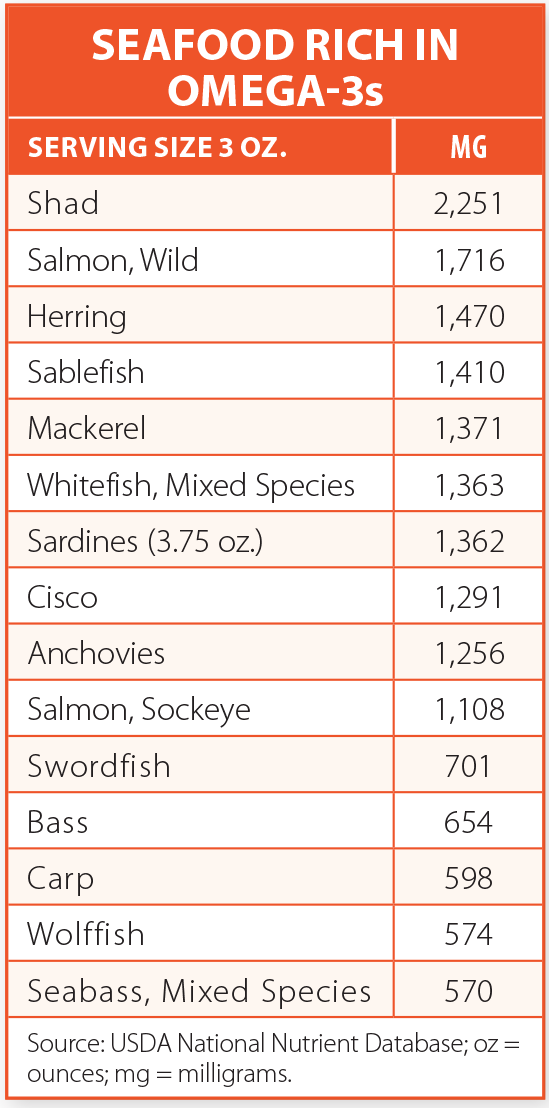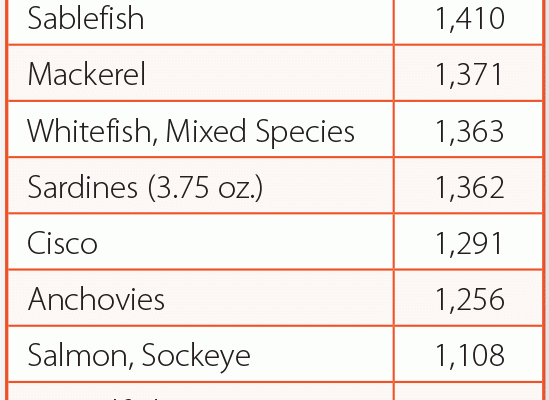Fish’s Benefits to Your Overall Health
Eating fish that are rich in omega-3 fatty acids is one of the best things you can do to maintain and improve your overall health. The American Heart Association recommends that adults eat 8 ounces a week, or the equivalent of two servings. And a 22-year study of 2,600 people published in BMJ reported that those who had the highest levels of omega-3 fatty acids in their bloodstream were at lower risk of chronic disease and physical or cognitive dysfunction than those who had the lowest levels of omega-3s in their system.
Other research has linked fish consumption to lower blood pressure and reduced risk of dementia, stroke, heart attack, and death from cardiovascular disease. And yet most Americans don’t eat enough fish—less than 16 pounds per person annually.
“Seafood is a good source of protein, healthy omega-3 fats (docosahexaenoic and ecosapentaenoic fatty acids), vitamins B12 and D, and iron,” says Rachel Lustgarten, a registered dietitian nutritionist with Weill Cornell Medicine. “Eating a wide variety of all foods—
including fish—is a good idea for optimal health. The fattier fishes are excellent sources of omega-3s, including salmon, tuna, mackerel, and sardines.”
GRILLING FISH, STEP-BY-STEP
- Preheat a gas or charcoal grill, thoroughly clean the grate, then wipe the grate several times with a handful of paper towels dipped in vegetable oil.
- Lightly oil both sides of the fish fillet, then place it skin-side down diagonally to the grill grate.
- Season to taste.
- Close the lid and grill the fish for 2-4 minutes until the skin is brown and the fillet releases to a gentle lift of a curved fish spatula. Flip and grill until an instant-read thermometer
in the thickest part reads 125°-135°F.
That doesn’t mean you should skip such less-fatty choices as tilapia, the most popular farmed fish in the U.S. Even leaner fish contain some omega-3s, and they replace less-healthy fare on your plate, such as pizza or burgers.
Healthy Cooking
Some of those health benefits are lost, however, when fish is breaded and/or fried, adding calories and saturated fat. In fact, research has shown that the cognitive benefits of fish consumption don’t apply to fried fish.
The good news is that you have plenty of better options. “Fish is fast and easy to cook and can be prepared healthfully in a number of different ways,” says Lustgarten. “Try grilling or baking (particularly “en papillote,” which is wrapping the fish in parchment paper with vegetables, herbs, and spices). Most fish-cooking methods take only about 10 minutes.”
Fish also can be gently poached in water or stock, with aromatic vegetables for extra flavor. Sautéing in a little olive oil is preferable to deep-frying, and “breading” with finely chopped nuts is a healthier alternative. You can even microwave fish, but be careful not to overcook it.
 Because most fish is mild in flavor, it takes well to brightening with citrus, such as lemon or lime, and herbs like dill, chives, thyme, rosemary, and sage. Add zip with peppers for fish tacos or go bold with spicy pastes like harissa.
Because most fish is mild in flavor, it takes well to brightening with citrus, such as lemon or lime, and herbs like dill, chives, thyme, rosemary, and sage. Add zip with peppers for fish tacos or go bold with spicy pastes like harissa.
Frozen and Canned
If the variety of fresh fish at your supermarket is limited, don’t hesitate to explore the freezer section. Fish labeled “Frozen at Sea” (FAS), processed and flash-frozen onboard soon after it’s caught, often can be fresher than “fresh” fish that sat on ice in transport and at the market for days. Buy packages that show no sign of tearing, crushing, frost, or ice crystals. Dig down to find fish that’s frozen hard.
Ideally, thaw frozen seafood gradually overnight in the refrigerator. In a pinch, seal in a ziptop bag and immerse in cold water.
Canned fish, packed in water rather than oil, is another convenient, nutritious choice. (Check labels to avoid added sodium.) Omega-3s mostly survive the canning process; look for albacore (“white”) tuna rather than skipjack (“light”) to get the most. Canned salmon, mackerel, and sardines also provide calcium, since the heat of cooking and canning makes the bones edible. Three ounces of canned salmon contain about as much calcium as a cup of milk.
You can add canned fish to casseroles with no further loss of nutrients as the dish cooks. Avoid preparations heavy on full-fat mayonnaise, canned soups, cheese, or refined grain products.
Consumption Cautions
Seafood is not without its downsides, however. “Everyone should be concerned with inadvertent mercury consumption through seafood,” Lustgarten notes. “Particularly at-risk groups include women who are trying to conceive, and are pregnant or nursing. Pregnant women should limit fish/seafood intake to 8 ounces a week.” Large predatory fish such as shark, swordfish, tilefish, or king mackerel are most prone to mercury; haddock, flounder, pollock, and tilapia are among fish lowest in mercury.
Sustainability is another concern. The Monterey Bay Aquarium’s Seafood Watch (www.seafoodwatch.org) is a handy guide to sustainable choices.
The post Fish’s Benefits to Your Overall Health appeared first on University Health News.
Read Original Article: Fish’s Benefits to Your Overall Health »


